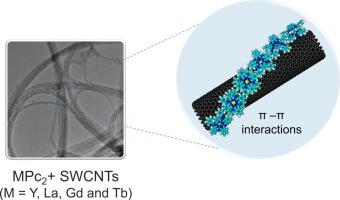含双层酞菁的碳纳米管非共价外面体功能化
IF 6.9
2区 材料科学
Q2 CHEMISTRY, PHYSICAL
引用次数: 0
摘要
单壁碳纳米管与钇、镧、钆和铽双层酞菁(或双酞菁)通过丁醇回流过程实现了外面体功能化。用光谱和显微相结合的技术证实了与双酞菁的非共价官能化。红外和x射线光电子能谱分析表明没有新的键,验证了酞菁与纳米管的非共价相互作用。扫描和透射电子显微镜分析显示,双酞菁复合物在纳米管表面均匀分布。热重分析表明,混合燃料的燃烧开始于约300 °C,结束于620 ~ 650 °C之间。观察到,与原始纳米管相比,金属配合物的掺入使热稳定性降低了大约50-100 °C,具体取决于金属。此外,混合材料中双层结构的重量百分比随金属的不同而不同,YPc2为28.7 %,LaPc2为26.4 %,GdPc2为30.6 %,TbPc2为25.9 %。本文章由计算机程序翻译,如有差异,请以英文原文为准。

Noncovalent exohedral functionalization of carbon nanotubes with double-decker phthalocyanines
The exohedral functionalization of single-walled carbon nanotubes with yttrium, lanthanum, gadolinium, and terbium double-decker phthalocyanines (or bisphthalocyanines) was achieved via a reflux process in butanol. The noncovalent functionalization with the bisphthalocyanines was confirmed using a combination of spectroscopic and microscopic techniques. Infrared and X-ray photoelectron spectroscopy analyses indicated the absence of new bonds, verifying that the phthalocyanines interact noncovalently with the nanotubes. Scanning and transmission electron microscopy analyses revealed a uniform distribution of the bisphthalocyanines complexes across the nanotube surfaces. Thermogravimetric analysis showed that combustion of the hybrids started at approximately 300 °C and ended between 620 and 650 °C. The incorporation of metal complexes was observed to decrease the thermal stability by roughly 50–100 °C compared to the pristine nanotubes, depending on the metal. Additionally, the weight percentage of double-decker structures in the hybrids varied with the metal, reaching 28.7 % for YPc2, 26.4 % for LaPc2, 30.6 % for GdPc2, and 25.9 % for TbPc2.
求助全文
通过发布文献求助,成功后即可免费获取论文全文。
去求助
来源期刊

Applied Surface Science
工程技术-材料科学:膜
CiteScore
12.50
自引率
7.50%
发文量
3393
审稿时长
67 days
期刊介绍:
Applied Surface Science covers topics contributing to a better understanding of surfaces, interfaces, nanostructures and their applications. The journal is concerned with scientific research on the atomic and molecular level of material properties determined with specific surface analytical techniques and/or computational methods, as well as the processing of such structures.
 求助内容:
求助内容: 应助结果提醒方式:
应助结果提醒方式:


